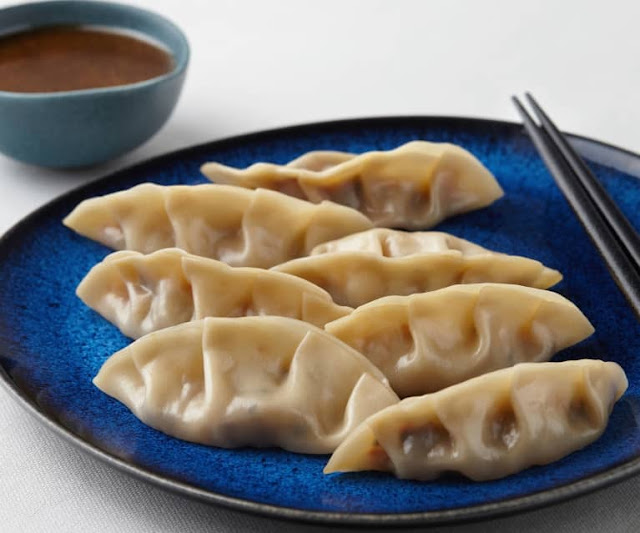Ramen Broth
1kg/2.2lb pork soup bones (note 1)
1 onion , peeled
3 green onions green part only
3cm/1¼” cube ginger , cut in half
2 cloves garlic
10g/0.4oz bonito flakes in a spice bag (note 2)
- 2 tbsp konbu soy sauce (note 3)
- 1½ tsp mirin
- salt to adjust flavour
- 300-400ml/10-13.5oz Ramen Broth in this recipe , boiling hot
Drain and wash the bones under running cold water one by one, removing coagulated blood, guts along the spine of the chicken and other brown dirty bits.
Add the cleaned bones and the rest of the Ramen Broth ingredients, excluding bonito flakes, to a large pot with 4L/8.5pt water, and bring it to a boil.
When scum surfaces, occasionally scoop it off gently using a ladle (note 5). Do not mix the broth with the ladle when removing the scum as it will cause the broth to become cloudy.
After removing the scum 4-5 times, turn down the heat to simmer gently.
While simmering, remove scum a few more times in the beginning if required.
Simmer for 2 hours with a lid on but allowing for slight ventilation. Then add a bag of bonito flakes. Simmer for a couple of minutes.
- Turn the heat off. Put the broth through a sieve and collect only the liquid.
Put konbu soy sauce and mirin in a serving bowl.
Boil water in a saucepan, and cook noodles and drain very well.
Add Ramen Broth to the bowl and mix. Taste test the soup and adjust with salt.
Add the noodles. Place sliced Yakibuta, Ramen Eggs, and shraga negi on top and slide a yaki nori on the side of the bowl. Serve immediately.
1. My soup bones were back bones chopped into small pieces. If you have pork leg bones, that’s fine too. Ask the butcher to chop them in half.
2. Spice bags are usually made with muslin. If you have a piece of muslin, you can wrap bonito flakes in the muslin and tie the edges to make a bag just like bouquet garnis.
At Japanese grocery stores, you can also buy a pack of disposable dashi stock bags in which you can stuff bonito flakes and seal (see the photo below).
Alternatively, you can use a store-bought granular bonito dashi pack as long as it does not contain anything other than bonito flakes.
3. How to make konbu soy sauce (4 servings):
Cut 10cm x 5cm/ 4” x 2” konbu into about a dozen small pieces.
Add the konbu pieces and 120ml/4.1oz soy sauce in a jar.
Leave it in the fridge overnight up to 1 week.
If you don't have konbu, just use the same amount of soy sauce.
You can use konbu soy sauce in place of pouring soy sauce to the dishes, e.g. Chilled Tofu, Spinach Ohitashi Salad, Japanese Okura with Bonito Flakes.
4. Time to cook noodles varies depending on the type of noodles. You may also change the duration if you prefer the noodles to be firmer or softer. Follow the instructions on the pack as a guideline.
5. Instead of a ladle, you can use a flat sieve with fine mesh like this.
6. Depending on the diameter of the pot and the temperature of the cooktop, the amount of the broth you get varies.
If the water evaporates too fast, add boiling water to increase the quantity. If too much soup stock is remaining, cook further to reduce the quantity.
7. The topping of shōyu ramen is based on my recipe, Easy Japanese Rame Noodles. You can of course change the toppings to your favourites.
8. Making Ramen Broth using a slow cooker:
- After step 2, add bones, vegetables, and water to a slow cooker. You may not be able to add 4L/8.5pt of water if the slow cooker is not large. Add as much as possible and ensure that bones are submerged in the water. You can place the pork bones inside the chicken carcass. Alternatively, break the chicken carcass into smaller pieces.
- Set the slow cooker to low for 10 hours (preferred) or high for 6 hours. Because the broth is cooked slowly at low temperature, there should be hardly any scum.
- Put the broth through a sieve and collect only the liquid into a large pot.
- Simmer for 15 minutes or so to reduce the liquid to 1.6L/3.4pt. If there is not enough broth, add water to make it 1.6L/3.4pt.
- Add a bag of bonito flakes to the pot and simmer for a couple of minutes, then remove the bonito flakes.
9. Making Ramen Broth using a pressure cooker:
- After step 2, add bones, vegetables, and water to a pressure cooker. You may not be able to add 4L/8.5pt of water if the pressure cooker is not large. I could add 3L/6.3pt.
- Follow the steps 4 & 5, then put the lid on over high heat.
- Pressure cook for 80 minutes. Turn the heat off and leave until the steam has naturally subsided.
- Put the broth through a sieve and collect only the liquid into a pot.
- If the liquid is more than 1.6L / 3.4pt, boil and reduce the quantity. If not enough broth, add water.
- Add a bag of bonito flakes to the pot and simmer for a couple of minutes, then remove the bonito flakes.
10. Ramen Broth can keep for a week or so in the fridge as long as it is brought to a boil every day and quickly cooled down, then place it in the fridge. You can also freeze the broth. It is more convenient to divide the broth into a serving size and freeze.












